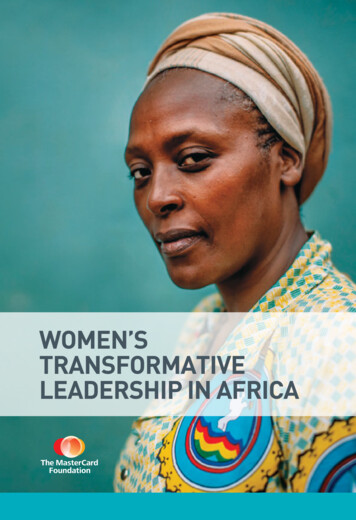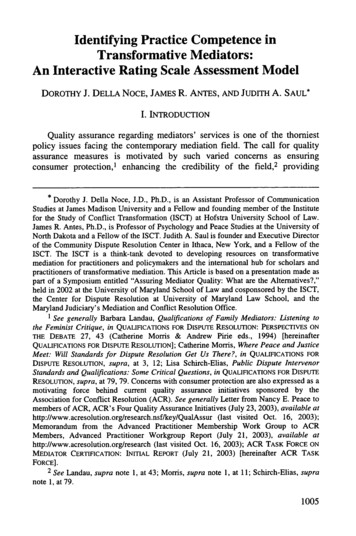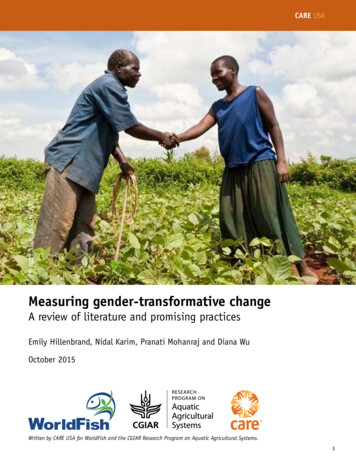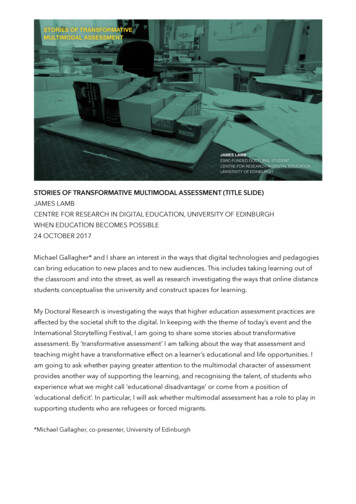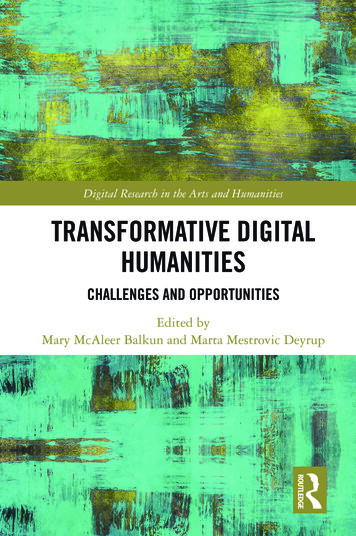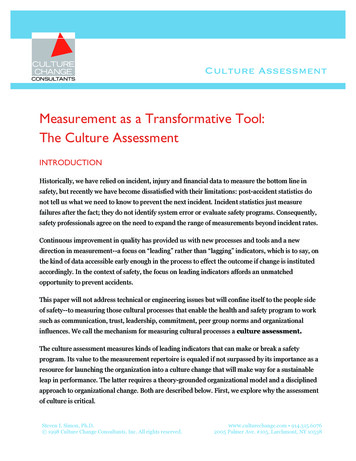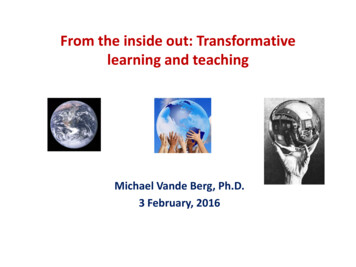
Transcription
From the inside out: Transformativelearning and teachingMichael Vande Berg, Ph.D.3 February, 2016
Warming ourselves up& introducing ourselvesIn small groups, please discuss and then sharewith the group what “transformative learningaway from home” means to you.
A century of intercultural learning abroad What is the nature of learning across cultures? What is the process by which humans learn acrosscultures? How can humans be taught or trained to do this?*Vande Berg, M. & Paige, R. M. (2009). Applying theory and research: The evolution of interculturalcompetence in U.S. study abroad. In Deardorff, D. (Ed.), The Sage Handbook of InterculturalCompetence (pp. 419-437). Thousand Oaks, CA: SAGE.Michael Vande Berg, Ph.D., 2016
Three dominant narratives—our community’s“stories”—about learning across cultures1. Humans become more cultured by learning superiorideas and emulating cultivated behavior.2. Humans become more culturally aware through talkingabout and being immersed in cultural differences.3. Humans develop interculturally through focusing ontheir own and others’ ways of making meaning, and bylearning to respond effectively and appropriately toculturally different others.Vande Berg, M., Paige, R. M., & Lou, K. H. (Eds.) (2012). Student learning abroad: what ourstudents are learning, what they’re not, and what we can do about it. Sterling, VA: Stylus.
Story 1: Positivism“Learning from the outside in”“. . . a real external world whose properties are definite andindependent of the observer who perceives them. . . . thingsare what they seem, as perceived through our senses.”(S. Hawking & L. Mladinow, 2012)
Story 1: Students encounter sophisticated,“civilized” people & places With the Grand Tour—this story’s signature program—learning occurs, in privileged places, through exposureto the new & different, and through modeling andimitation
Story 1 theories:The world is organized hierarchically
Students learn as we teach and expose them to anunfamiliar and privileged culture “out there” Students learn through exposure to the new and different inprivileged places. Students learn when educators describe,talk about, culture-specific differences.Michael Vande Berg, PhD, 2016
Story 1: TheoriesWe come to know through the scientific method
Story 1: Theories:Behaviorism
Story 1: The process of learning abroad, described1. Acquire knowledge about a privileged place andpeople2. Directly experience the place3. Emulate the behavior of cultivated people there4. Return home more “cultured”—moreknowledgeable and worldlyMichael Vande Berg, Ph.D., 2016
Story 1 theory:Social Darwinism“This survival of the fittest,which I have sought toexpress in mechanical terms,is that which Mr. Darwin hascalled ‘natural selection,’ orthe preservation of favouredraces in the struggle for life.”(Herbert Spencer, 1864)
Doubts about story 1:Accelerating erosion of faith in hierarchy
Story 2: Relativism“Learning from the outside in”—with a differenceMichael Vande Berg, PhD, 2016
Story 2 theory:Egalitarianism“The things we have in common far outnumber andoutweigh those that divide us.” Walt Disney
Story 2 Theory:“Immersion”
Story 2 Theory:Culture Shock**U-curve: Oberg, 1955; W-curve: Gullahorn & Gullahorn, 1963
Story 2: Theory“Contrast-culture” training approach“Differences that make a difference”: Non-verbal (eye contact, personal space, touching) Communication styles (direct/indirect) Learning styles (concrete experience/abstractconceptual) Cognitive styles (linear logic/spiraling logic) Value contrasts (individualism/collectivism)
Story 2: The process of learning abroad, described1. Learn about and become aware of cultural differences(contrast-culture learning)2. Immerse myself in the experience abroad—or educatorsimmerse me3. Return home more culturally aware, sensitiveQuestion: How do educators act out story 2?Question: To what extent does becoming more culturally awareallow us to cross cultural boundaries?Michael Vande Berg, Ph.D., 2016
Georgetown Study findings*: Do traditional“immersion” practices foster intercultural learning? Take steps to improve language proficiency: Little impactMaximize contact with host nationals: No impactEnrollment in host school classes: No impactCarry out internships, service learning: No impactBe housed in home stays: No impactSend away for longer periods: Yes—some impactPre departure cultural orientation: Yes—some impactHome stays: Yes—when students engaged with host familyCultural mentoring at sites abroad: Yes—by far the highestimpact practice in the study*Vande Berg, M.; Connor-Linton, J.; & Paige, R. M. The Georgetown Consortium Study:Intervening in student learning abroad. Frontiers: the Interdisciplinary Journal ofStudy Abroad. Vol. XVIII, pp. 1-75.Michael Vande Berg, Ph.D., 2016
Story 3: ConstructivismLearning “from the inside out”: Acting on ourawareness of our own and others’ sense-making
Story 3: Reflection and self awareness “There is no way to removethe observer—us—from ourperception of the world. . . . Ourperception is not direct, butrather is shaped by a kind of lens,the interpretive structure of ourhuman brains. . . . Our brainsinterpret the input from oursensory organs by making amodel of the world.”(Hawking & Mladinov,The grand design, 2012) “People don’t learn through experience; we learnthrough reflecting on experience.” (Sivasailam Thiagarajan—”Thiagi”)
Story 3 Theory:“Paradigms”*A paradigm shift “is a reconstruction of the field fromnew fundamentals that changes some of the field’smost elementary theoretical generalizations, as wellas many of its methods and applications. . . . Whenthe transition is complete, the profession will havechanged its view of the field, its methods, and itsgoals.”* Thomas Kuhn
Story 3: TheorySocial construction of reality** Berger & Luckmann: We and other members of our culturalgroups construct the world we perceive and live in.
Edward T. Hall (1994) & the foundational aim of crossingcultures: “Bridging the cultural gap” “[Not understanding the Navajo] drove me to look at myown culture, my own assumptions, those beliefs that are outof awareness.” “It is the out-of-awareness, tacit differences among us,which lie at the heart of the tremendous misunderstandingsthat plague our species.” “When cultures meet and startinteracting with each other, evenwell-chosen words may not beenough to bridge the cultural gap.”
Narrative 3 theory to practice:A four-phase transformative training program Increasing awareness of our own characteristic waysof making meaning in familiar and unfamiliar culturalcontexts; Increasing awareness of others’ ways of makingmeaning in familiar and unfamiliar cultural contexts; Managing our emotions and thoughts in the face ofambiguity, change, and challenging circumstances &people; and Bridging cultural gaps between ourselves and others:Shifting frames, attuning our emotions and adaptingour behavior in effective and appropriate ways.Michael Vande Berg, PhD, 2016
Phase I: Key concepts Constructivism and meaning makingPerceptionHolistic experienceObjective and subjective cultureDevelopment and transformationChallenge and supportIdentity: Assumptions, values and behaviorMindfulnessMichael Vande Berg, PhD, 2016
Phase I: Practices Attend to the autobiographical “I”Attend to the mindful “Me”Recall my personal vision statementRecall my characteristic ways of responding toambiguity and uncertainty Recall my assumptions about intercultural learning andteaching Attend to ways that my values and behavior play outdifferently in different contextsMichael Vande Berg, PhD, 2016
Phase II: Key concepts Suspension of judgmentValue formationMindful perceptionEmpathyValues and behaviorMichael Vande Berg, PhD, 2016
Phase II: Practices Perceive non-judgmentallyCultivate curiosityGenerate multiple interpretationsListen & observe mindfullyInquire mindfullyAttend to values & limitations of all perspectivesCultivate cognitive empathyMichael Vande Berg, PhD, 2016
Learning is “the process through whichknowledge is created through thetransformation of experience.” (Kolb, 1984)“All knowing depends on the structure of the knower.”(Maturana & Varela, 1992)Also see Zull, J. (2002). The art of changing the brain. Sterling, VA: Stylus.
Another model describing “the structure of the knower”:The Intercultural Development Continuum (IDC)DeeplyComprehendsDifferenceBridges alMindsetCopyright, 1998-2013, Mitchell R. Hammer, Ph.D., IDI, LLC, used with permissionModified from the DevelopmentalModel of Intercultural Sensitivity(DMIS), M. Bennett, 1986
Another model offering insights into “thestructure of the knower”: Challenge & support**Challenge/Support Hypothesis: Sanford, N. (1966). Self and society: Socialchange and individual development. New York: Atherton Press.
Introducing challenge and support:Warm up questions* What kind of environment do I need in thiscourse/workshop/orientation so I’m able to get out ofmy comfort zone, yet not go into the panic zone?– How can the teacher/trainer/facilitator contribute to gettingme into the learning zone?– How can the other participants contribute to getting me intothe learning zone?– What can I do to get myself into the learning zone? What can I do, based on what I’ve just heard my peerssay, to help others get in and stay in their learning zonein this workshop, much of the time?Tara Harvey, Ph.D., 2016
Intercultural teaching and learning resources WISE Conference (February) Summer Institute for Intercultural Communication (SIIC, July) Winter Institute for Intercultural Communication (WIIC, March) Personal Leadership Mindfulness Based Stress Reduction (MBSR) Berardo, K. & Deardorff, D. Building cultural competence: Innovativeactivities and models. Sterling, VA: Stylus. Cassiday, P. & Stringer, D. (2014). 52 activities for successful internationalrelocation. Boston: Intercultural Press. Storti, C. (1999). Figuring foreigners out: A practical guide. Boston:Intercultural Press. Stringer, D. M. & Cassiday, P. A. (Eds.) (2009). 52 Activities for improvingcross-cultural communication. Boston: Intercultural Press. Stringer, D. M. & Cassiday, P. A. (Eds.) (2003). 52 Activities for exploringvalues differences. Boston: Intercultural Press. Thiagarajan, S. (“Thiagi”). (2004). Simulation Games by Thiagi.Bloomington, IN: Workshops by Thiagi.Michael Vande Berg, Ph.D., 2016
Intercultural teaching and learning resources WISE Conference (February) Summer Institute for Intercultural Communication (SIIC, July) Winter Institute for Intercultural Communication (WIIC, March) Personal Leadership Mindfulness Based Stress Reduction (MBSR) Berardo, K. & Deardorff, D. Building cultural competence .


